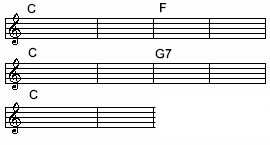Scroll through the lesson and click on notation/video/audio links to load the interactive players.
Please subscribe to get full access to all lessons for only $7.95/month PLUS 1 week free trial.

Riff Interactive lessons are
LESS expensive and
MORE interactive than alternatives!
More Info
|
|

Country Guitar For
Beginners
Lesson 1
Lyle:
The country guitar style is a lot like the blues style. Simple chord
progressions with not much clutter, just real straight forward grooves. The
Lesson Sample is what you'll be learning here in this first lesson, a specific
rhythm riff that uses alternating and walking bass lines, and a cool solo guitar
riff that emulates the sound and style of the pedal steel guitar most often used
in country music.
Lyle: There will be three basic chords used for
this "country style" riff; C, F, and G7. Notice in the C and F chords I'm
suggesting you hold down the 3rd and 4th fingers, this will make it easier for
you to play the "alternating bass" lines.
Lyle:
These three chords are also called the 1 - 4 - 5 chords in the key of C. C is
the 1 chord, F is the 4th chord, and G7 is the 5th chord in the key of C.
chords

Lyle:
The alternating bass line for these three chords comes from notes in the C major
scale:
Lyle:
When you want to use the alternating bass note riffs, it's good to use the root
and 5th of each chord. Examine this next tab:
Lyle:
Most country style songs are in major keys. The G7 is the 5 chord in the key of
C. The 5 chord can be major or the dominant 7 chord like the G7.
Lyle:
The "7", like the G7, is very common and gives you the extra "twangy" sound
compared to using a plain G major chord.
Lyle:
The rhythm riffs to this progression have walking bass lines as well as the
alternate bass lines. To go from the C to F chord you'll walk up like this:
Lyle:
Once you learn all these little things to practice, I'll put it all together for
you.
Lyle: To walk down from the F to the C will be
like this:
Lyle:
The C to G7 and back to C transition is like this:
Lyle:
We're very close to putting it all together. The strum pattern is all down
strums, once for each beat. Here's what a two measure rhythm riff looks like for
the C chord using alternate bass notes every other beat:
Lyle:
Root - strum, 5th - strum, root - strum, 5th - strum. All down strums or
strokes.
Lyle: Here's how the chord progression looks for
the complete country groove you will be learning:
chord
chart

Lyle: Now you're ready to combine all the things
you just practiced, the alternating bass notes for each chord, and the walking
bass lines that are the transitions to each chord change:
Lyle:
Once you have learned the rhythm riff, try playing along to this looping jam
track:
Lyle:
The country style lead guitar is mostly done on a pedal steel guitar but you can
learn how to get that sound on a regular guitar.
Lyle:
Since this jam is in C, the C major pentatonic scale is the best scale to make
riffs from:
Lyle:
Here's a basic steel guitar riff made from the C maj pentatonic. Use your pinky
to barre the 1st and 2nd strings, your 3rd finger to bend up a whole step:
Lyle: I
like to use my thumb for the 3rd string, index and middle fingers for the other
two strings, then pluck all three at the same time. You'll see this technique in
the video. Also notice the sound of the bend and release of the bend.
Lyle:
The riff example you just learned is for the C chord, notice you're at the 8th
fret with your pinky, that's where the high C note is.
Lyle:
When playing country style riffs like this, you simply follow the chords during
the progression. Here's where you'll move your left hand to follow the three
chords used in this lesson:
Lyle:
Follow the chords using the major pentatonic scale patterns. Earlier you learned
the C major pent. Simply move that pattern up the neck to get to the F and G
positions:
Lyle:
Now you're ready to learn a solo using this riff with the whole progression:
Lyle:
Now we just need to put words to this. We have to include the words Mom, train,
drunk, truck, and gun.
Lyle: ..and dog or horse.
Mike:
Don't forget about the x-girlfriend
Lyle: I try to ...
Mike: Ha
ha!
Lyle:
Any questions so far?
Mike: Are there any altered scales you think might sound
alright with this?
Lyle: An altered scale might give you the jazz
sound. And the jazz sound against this type of groove, which is very "un-jazz"
and so-country would be hard to fit.
Lyle: Keep it simple by using the major
pentatonics and you'll do very well.
Mike: O.k. pent. are fun.
paul:
...and easy!
Lyle: That's all for this lesson. In the lessons
to come you'll be expanding on these riffs and learning how to play these riffs
against different keys.
Lyle: Get real good at the bending riff, you'll
be using it a lot in the country style.
Rich: Thanks I appreciate this. I needed some good
explanation on the walking base.
Lyle: I think you'll learn a few more like it in
the following lessons.
Lyle: Ok, well good night pickers, See y'all next
week, y'all come back now, ya hear?
|
<< load notation from left
|
|
<< load audio from left
|
<< load audio from left
|